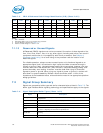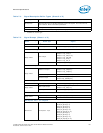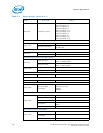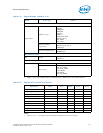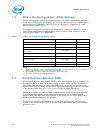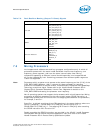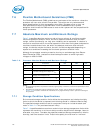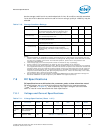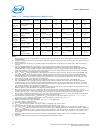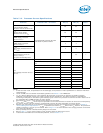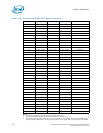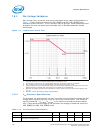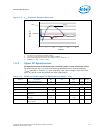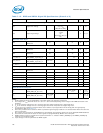
Electrical Specifications
142 Intel® Xeon® Processor E5-1600 v2/E5-2600 v2 Product Families
Datasheet Volume One of Two
Notes:
1. Unless otherwise noted, all specifications in this table apply to all processors. These specifications are based on final silicon
characterization.
2. Individual processor VID values may be calibrated during manufacturing such that two devices at the same speed may have
different settings.
3. These voltages are targets only. A variable voltage source should exist on systems in the event that a different voltage is
required.
4. The V
CC
voltage specification requirements are measured across the remote sense pin pairs (VCC_SENSE and
VSS_VCC_SENSE) on the processor package. Voltage measurement should be taken with a DC to 100 MHz bandwidth
oscilloscope limit (or DC to 20 MHz for older model oscilloscopes), using a 1.5 pF maximum probe capacitance, and 1M Ω
minimum impedance. The maximum length of the ground wire on the probe should be less than 5 mm to ensure external
noise from the system is not coupled in the scope probe.
5. The V
TTA,
and V
TTD
voltage specification requirements are measured across the remote sense pin pairs (VTTD_SENSE and
VSS_VTTD_SENSE) on the processor package. Voltage measurement should be taken with a DC to 100 MHz bandwidth
oscilloscope limit (or DC to 20 MHz for older model oscilloscopes), using a 1.5 pF maximum probe capacitance, and 1M Ω
minimum impedance. The maximum length of the ground wire on the probe should be less than 5 mm to ensure external
noise from the system is not coupled in the scope probe.
6. The V
SA
voltage specification requirements are measured across the remote sense pin pairs (VSA_SENSE and
VSS_VSA_SENSE) on the processor package. Voltage measurement should be taken with a DC to 100 MHz bandwidth
oscilloscope limit (or DC to 20 MHz for older model oscilloscopes), using a 1.5 pF maximum probe capacitance, and 1M Ω
minimum impedance. The maximum length of the ground wire on the probe should be less than 5 mm to ensure external
noise from the system is not coupled in the scope probe.
7. The processor should not be subjected to any static V
CC
level that exceeds the V
CC_MAX
associated with any particular current.
Failure to adhere to this specification can shorten processor lifetime.
8. Minimum V
CC
and maximum I
CC
are specified at the maximum processor case temperature (T
CASE
) shown in Chapter 5.
I
CC_MAX
is specified at the relative V
CC_MAX
point on the V
CC
load line. The processor is capable of drawing I
CC_MAX
for up to 5
seconds. Refer to Figure 7-4 for further details on the average processor current draw over various time durations.
9. The processor should not be subjected to any static V
TTA,
V
TTD
level that exceeds the V
TT_MAX
associated with any particular
current. Failure to adhere to this specification can shorten processor lifetime.
10. This specification represents the V
CC
reduction or V
CC
increase due to each VID transition, see Section 7.1.9.3, “Voltage
Identification (VID)”. AC timing requirements for VID transitions are included in Table 7-23.
11. Baseboard bandwidth is limited to 20 MHz.
12. FMB is the flexible motherboard guidelines. See Section 7.6 for FMB details.
13. DC + AC + Ripple = Total Tolerance
14. For Power State Functions see Section 7.1.9.3.5.
15. V
SA_VID
does not have a loadline, the output voltage is expected to be the VID value.
16. V
CCD
tolerance at processor pins. Tolerance for VR at remote sense is ±3.3%*V
CCD
.
17. The V
CCPLL
, V
CCD01
, V
CCD23
voltage specification requirements are measured across vias on the platform. Choose V
CCPLL
,
V
CCD01
, or V
CCD23
vias close to the socket and measure with a DC to 100MHz bandwidth oscilloscope limit (or DC to 20MHz for
older model oscilloscopes), using 1.5 pF maximum probe capacitance, and 1M Ω minimum impedance. The maximum length
of the ground wire on the probe should be less than 5 mm to ensure external noise from the system is not coupled in the
scope probe.
18. VCC has a Vboot setting of 0.0V and is not included in the PWRGOOD indication. Refer to the compatible VR12.0 PWM
controller.
19. VSA has a Vboot setting of 0.9V. Refer to the compatible VR12.0 PWM controller.
V
VID_STEP
(Vcc, Vsa,
Vccd)
VID step size during
a transition
5.0 mV 10
V
CCPLL
PLL Voltage V
CCPLL
0.955*V
CCPLL_TYP
1.7 1.045*V
CCPLL_TYP
V
11, 12, 13,
17
V
CCD
(
V
CCD_01,
V
CCD_23)
I/O Voltage for
DDR3 (Standard
Voltage)
V
CCD
0.95*V
CCD_TYP
1.5 1.05*V
CCD_TYP
V
11, 13, 14,
16, 17
V
CCD
(
V
CCD_01.
V
CCD_23)
I/O Voltage for
DDR3L (Low
Voltage)
V
CCD
0.95*V
CCD_TYP
1.35 1.075*V
CCD_TYP
V
11, 13, 14,
16, 17
V
TT (
V
TTA,
VTTD)
Uncore Voltage
(Launch - FMB)
V
TT
0.957*V
TT_TYP
1.00 1.043*V
TT_TYP
V
3, 5, 9, 12,
13
V
SA_VID
Vsa VID Range V
SA
0.6 0.940 1.25 V 2, 3, 14, 15
V
SA
System Agent
Voltage
(Launch - FMB)
V
SA
V
SA_VID
- 0.057 V
SA_VID
V
SA_VID
+ 0.057 V
3, 6, 12,
14, 19
Table 7-11. Voltage Specification (Sheet 2 of 2)
Symbol Parameter
Voltage
Plane
Min Typ Max Unit Notes
1



